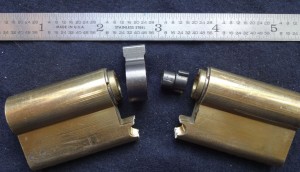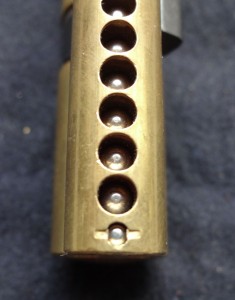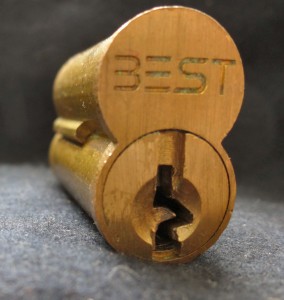Unlike the non-destructive attacks above, these will leave no doubt that the lock was compromised. Once done, the lock is destroyed. Still, there are occasions when this may be your only option – say, a customer needs immediate access through a high security cylinder. Law Enforcement, medical, fire, or other emergency responders may only use destructive techniques because the situations they face (injured, ill or incapacitated victims) cannot spare the time necessary for a non-destructive entry.
Rapping
The first technique is actually only potentially destructive, but it does leave considerable forensic evidence. It’s effective against padlocks that use spring-loaded locking pawls to secure the shackle. It will not work on locks secured with ball bearings. While not exactly surreptitious, there are two approaches to “rapping” open these padlocks. The first requires a single small hammer and a large rubber band. With the lock hanging from the hasp, feed the rubber band through the shackle and apply downwards tension. Strike on one side, then the opposite side of the lock body. The impacts will overcome the spring resistance, forcing the locking pawl away from the shackle cutout. If the lock contains two locking pawls you’ll have to alternate rapping the sides several times but the rubber band’s constant downward tension will keep the springs from pushing the pawls back into the cutouts. After alternating several times the pawls will fail and the lock will open. A slightly faster method needs only two hammers but a bit more coordination. With the lock hanging from the hasp, hit both sides simultaneously with a solid whack. Both locking pawls will react to the impact and the lock will open. There are limitations to rapping, namely the strength of the pawl spring. Rapping works very quickly on locks containing cheap, weak springs, like those found in Master Locks. More powerful springs require more downward tension, harder raps, and more of them to be effective. Some padlocks contain springs so powerful that no amount of rapping can get them open.
.
.
Snapping Euro Cylinders
 When faced with Euro cylinders the fastest way to gain access is by “snapping” the lock in half. A snapping tool is attached to the front of the lock, taking advantage of the leverage offered by the protruding cylinder. Pictured is a Euro cylinder that has suffered a snap attack. Notice it broke on the thinnest part of the spine, a known weakness of this design.
When faced with Euro cylinders the fastest way to gain access is by “snapping” the lock in half. A snapping tool is attached to the front of the lock, taking advantage of the leverage offered by the protruding cylinder. Pictured is a Euro cylinder that has suffered a snap attack. Notice it broke on the thinnest part of the spine, a known weakness of this design.
Tightening a bolt eventually breaks the lock spine, the weakest part of the lock body. Once the lock is snapped in half, the broken portion is removed and the actuator manipulated with a screwdriver to open the door. A skilled operator can snap an unprotected lock in less than a minute – the key word being “unprotected”. In recent years manufacturers have started reinforcing the spine of the lock with hardened steel shims and rods, making the snapping tools ineffective. This protection is expensive so only the higher end (read: more expensive) locks have this feature, leaving millions of vulnerable locks out there.
Drilling the Shear Line
 Most locks are constructed from brass or soft metals as a cost saving measure. A favorite fast entry technique is simply to use a ¼” to ½” drill bit to remove the entire shear line, and then use a screw driver to force the core. This technique doesn’t require specialized tools or much experience to succeed. Lock manufacturers, especially the more expensive high security models, now contain carbide inserts or ball bearings to protect the shear line by deflecting the drill bit.
Most locks are constructed from brass or soft metals as a cost saving measure. A favorite fast entry technique is simply to use a ¼” to ½” drill bit to remove the entire shear line, and then use a screw driver to force the core. This technique doesn’t require specialized tools or much experience to succeed. Lock manufacturers, especially the more expensive high security models, now contain carbide inserts or ball bearings to protect the shear line by deflecting the drill bit.
Others use steel key pins and driver pins to accomplish the same thing, but at lower cost. The highest end locks are constructed of steel and have laminated hardened steel discs to stop the most durable of drill bits. Unfortunately, most low or mid-grade locks have no protection, meaning about 70-80% of house locks in North America are vulnerable to shear line drilling.
SFIC and LFIC Drilling Jigs
 The last destructive technique is very effective on lock housings containing the Small Format Interchangeable Core (SFIC) and Large Format Interchangeable Core (LFIC) locks. These types of cores can be quickly exchanged by using a control key to retract the built-in locking pawl, inserting the core, then re-locking the pawl. The pawl is located on the left side of the lock and, with a proper jig, can be precisely drilled out without damaging the lock housing.
The last destructive technique is very effective on lock housings containing the Small Format Interchangeable Core (SFIC) and Large Format Interchangeable Core (LFIC) locks. These types of cores can be quickly exchanged by using a control key to retract the built-in locking pawl, inserting the core, then re-locking the pawl. The pawl is located on the left side of the lock and, with a proper jig, can be precisely drilled out without damaging the lock housing.
This is important for locksmiths because when their customer loses the key, the locksmith can quickly drill out the SFIC or LFIC core and install a replacement within minutes. In the picture you can see the locking pawl protruding from the side of the SFIC body. This is what secures the lock inside the lock housing. Drilling it out allows the core to slip out of the housing, exposing the lock pawl, which you turn with a flat-blade screwdriver.
Criminals are aware of this technique as well, but rarely spend money on an expensive jig because they aren’t concerned with damaging the housing. They simply use a larger drill bit and use the core housing as their guide to remove the locking pawl. Once the pawl is removed, the core slides out, giving clear access to the actuator which you can turn with a screwdriver.